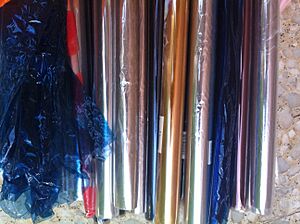Jacques E. Brandenberger facts for kids
Quick facts for kids
Jacques Edwin Brandenberger
|
|
|---|---|
| Born | 19 October 1872 |
| Died | 13 July 1954 (aged 81) Zurich, Switzerland
|
| Nationality | Swiss |
| Alma mater | University of Bern |
| Known for | Invention of cellophane |
| Awards | Elliott Cresson Medal (1937) |
| Scientific career | |
| Fields | Chemistry |
Jacques Edwin Brandenberger (born October 19, 1872 – died July 13, 1954) was a Swiss chemist. He was also a textile engineer. He is famous for inventing cellophane in 1908.
In 1937, he received a special award called the Elliott Cresson Medal from the Franklin Institute. This award recognized his important invention.
Who Was Jacques Brandenberger?
Jacques Brandenberger was born in Zurich, Switzerland. This happened in 1872. He studied at the University of Bern and finished his studies in 1895.
He was very interested in chemistry and how textiles (fabrics) are made. His work led to a discovery that changed how we package many things.
Inventing Cellophane
Brandenberger invented cellophane in 1908. He wanted to create a special coating. This coating would make cloth more resistant to stains. He used wood cellulose to make it. Cellulose is a natural material found in plants.
His first idea was to protect fabrics from spills. But the material he created, cellophane, turned out to be useful for many other things.
From Idea to Product
After his first invention, Jacques Brandenberger spent several years working. He made his cellophane even better. He refined the process and improved the material.
By 1920, he started making cellophane for industrial use. This means it was used by businesses and factories. In 1923, he sold the rights to make cellophane in the United States to a company called DuPont. This helped cellophane become widely known and used around the world.
Cellophane is still used today for packaging. It is clear and helps keep food fresh. It also protects many other products.


